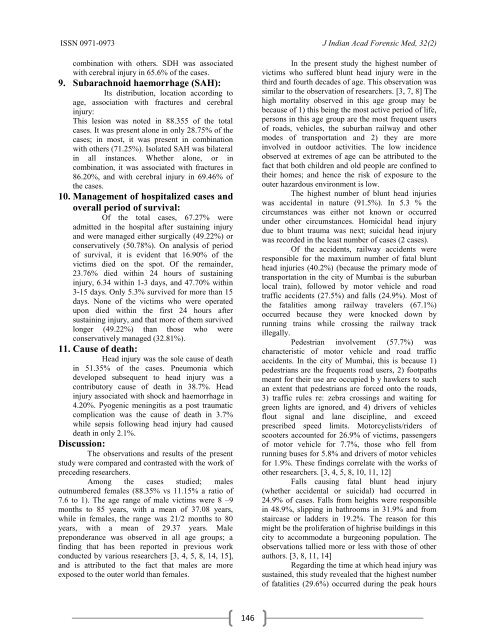jiafm, 2010-32(2) april-june. - forensic medicine
jiafm, 2010-32(2) april-june. - forensic medicine
jiafm, 2010-32(2) april-june. - forensic medicine
- No tags were found...
Create successful ePaper yourself
Turn your PDF publications into a flip-book with our unique Google optimized e-Paper software.
ISSN 0971-0973 J Indian Acad Forensic Med, <strong>32</strong>(2)combination with others. SDH was associatedwith cerebral injury in 65.6% of the cases.9. Subarachnoid haemorrhage (SAH):Its distribution, location according toage, association with fractures and cerebralinjury:This lesion was noted in 88.355 of the totalcases. It was present alone in only 28.75% of thecases; in most, it was present in combinationwith others (71.25%). Isolated SAH was bilateralin all instances. Whether alone, or incombination, it was associated with fractures in86.20%, and with cerebral injury in 69.46% ofthe cases.10. Management of hospitalized cases andoverall period of survival:Of the total cases, 67.27% wereadmitted in the hospital after sustaining injuryand were managed either surgically (49.22%) orconservatively (50.78%). On analysis of periodof survival, it is evident that 16.90% of thevictims died on the spot. Of the remainder,23.76% died within 24 hours of sustaininginjury, 6.34 within 1-3 days, and 47.70% within3-15 days. Only 5.3% survived for more than 15days. None of the victims who were operatedupon died within the first 24 hours aftersustaining injury, and that more of them survivedlonger (49.22%) than those who wereconservatively managed (<strong>32</strong>.81%).11. Cause of death:Head injury was the sole cause of deathin 51.35% of the cases. Pneumonia whichdeveloped subsequent to head injury was acontributory cause of death in 38.7%. Headinjury associated with shock and haemorrhage in4.20%. Pyogenic meningitis as a post traumaticcomplication was the cause of death in 3.7%while sepsis following head injury had causeddeath in only 2.1%.Discussion:The observations and results of the presentstudy were compared and contrasted with the work ofpreceding researchers.Among the cases studied; malesoutnumbered females (88.35% vs 11.15% a ratio of7.6 to 1). The age range of male victims were 8 –9months to 85 years, with a mean of 37.08 years,while in females, the range was 21/2 months to 80years, with a mean of 29.37 years. Malepreponderance was observed in all age groups; afinding that has been reported in previous workconducted by various researchers [3, 4, 5, 8, 14, 15],and is attributed to the fact that males are moreexposed to the outer world than females.In the present study the highest number ofvictims who suffered blunt head injury were in thethird and fourth decades of age. This observation wassimilar to the observation of researchers. [3, 7, 8] Thehigh mortality observed in this age group may bebecause of 1) this being the most active period of life,persons in this age group are the most frequent usersof roads, vehicles, the suburban railway and othermodes of transportation and 2) they are moreinvolved in outdoor activities. The low incidenceobserved at extremes of age can be attributed to thefact that both children and old people are confined totheir homes; and hence the risk of exposure to theouter hazardous environment is low.The highest number of blunt head injurieswas accidental in nature (91.5%). In 5.3 % thecircumstances was either not known or occurredunder other circumstances. Homicidal head injurydue to blunt trauma was next; suicidal head injurywas recorded in the least number of cases (2 cases).Of the accidents, railway accidents wereresponsible for the maximum number of fatal blunthead injuries (40.2%) (because the primary mode oftransportation in the city of Mumbai is the suburbanlocal train), followed by motor vehicle and roadtraffic accidents (27.5%) and falls (24.9%). Most ofthe fatalities among railway travelers (67.1%)occurred because they were knocked down byrunning trains while crossing the railway trackillegally.Pedestrian involvement (57.7%) wascharacteristic of motor vehicle and road trafficaccidents. In the city of Mumbai, this is because 1)pedestrians are the frequents road users, 2) footpathsmeant for their use are occupied b y hawkers to suchan extent that pedestrians are forced onto the roads,3) traffic rules re: zebra crossings and waiting forgreen lights are ignored, and 4) drivers of vehiclesflout signal and lane discipline, and exceedprescribed speed limits. Motorcyclists/riders ofscooters accounted for 26.9% of victims, passengersof motor vehicle for 7.7%, those who fell fromrunning buses for 5.8% and drivers of motor vehiclesfor 1.9%. These findings correlate with the works ofother researchers. [3, 4, 5, 8, 10, 11, 12]Falls causing fatal blunt head injury(whether accidental or suicidal) had occurred in24.9% of cases. Falls from heights were responsiblein 48.9%, slipping in bathrooms in 31.9% and fromstaircase or ladders in 19.2%. The reason for thismight be the proliferation of highrise buildings in thiscity to accommodate a burgeoning population. Theobservations tallied more or less with those of otherauthors. [3, 8, 11, 14]Regarding the time at which head injury wassustained, this study revealed that the highest numberof fatalities (29.6%) occurred during the peak hours146



![syllabus in forensic medicine for m.b.b.s. students in india [pdf]](https://img.yumpu.com/48405011/1/190x245/syllabus-in-forensic-medicine-for-mbbs-students-in-india-pdf.jpg?quality=85)



![SPOTTING IN FORENSIC MEDICINE [pdf]](https://img.yumpu.com/45856557/1/190x245/spotting-in-forensic-medicine-pdf.jpg?quality=85)

![JAFM-33-2, April-June, 2011 [PDF] - forensic medicine](https://img.yumpu.com/43461356/1/190x245/jafm-33-2-april-june-2011-pdf-forensic-medicine.jpg?quality=85)



![JIAFM-33-4, October-December, 2011 [PDF] - forensic medicine](https://img.yumpu.com/31013278/1/190x245/jiafm-33-4-october-december-2011-pdf-forensic-medicine.jpg?quality=85)


